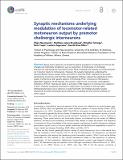Files in this item
Synaptic mechanisms underlying modulation of locomotor-related motoneuron output by premotor cholinergic interneurons
Item metadata
| dc.contributor.author | Nascimento, Filipe | |
| dc.contributor.author | Broadhead, Matthew James | |
| dc.contributor.author | Tetringa, Efstathia | |
| dc.contributor.author | Tsape, Eirini | |
| dc.contributor.author | Zagoraiou, Laskaro | |
| dc.contributor.author | Miles, Gareth Brian | |
| dc.date.accessioned | 2020-03-10T17:30:03Z | |
| dc.date.available | 2020-03-10T17:30:03Z | |
| dc.date.issued | 2020-03-09 | |
| dc.identifier | 266483367 | |
| dc.identifier | 3daee16f-c5a8-4e88-88ed-44c4af972939 | |
| dc.identifier | 85081944744 | |
| dc.identifier | 000519713500001 | |
| dc.identifier.citation | Nascimento , F , Broadhead , M J , Tetringa , E , Tsape , E , Zagoraiou , L & Miles , G B 2020 , ' Synaptic mechanisms underlying modulation of locomotor-related motoneuron output by premotor cholinergic interneurons ' , eLife , vol. 9 , e54170 . https://doi.org/10.7554/eLife.54170 | en |
| dc.identifier.issn | 2050-084X | |
| dc.identifier.other | ORCID: /0000-0002-8624-4625/work/70618975 | |
| dc.identifier.uri | https://hdl.handle.net/10023/19633 | |
| dc.description | F Nascimento was supported by The Alfred Dunhill Links Foundation. G B Miles and M J Broadhead received support from Biotechnology and Biological Sciences Research Council Grant BB/M021793/1. L Zagoraiou and E Tsape were supported by Fondation Santé. | en |
| dc.description.abstract | Spinal motor networks are formed by diverse populations of interneurons that set the strength and rhythmicity of behaviors such as locomotion. A small cluster of cholinergic interneurons, expressing the transcription factor Pitx2, modulates the intensity of muscle activation via ‘C-bouton’ inputs to motoneurons. However, the synaptic mechanisms underlying this neuromodulation remain unclear. Here, we confirm in mice that Pitx2+ interneurons are active during fictive locomotion and that their chemogenetic inhibition reduces the amplitude of motor output. Furthermore, after genetic ablation of cholinergic Pitx2+ interneurons, M2 receptor-dependent regulation of the intensity of locomotor output is lost. Conversely, chemogenetic stimulation of Pitx2+ interneurons leads to activation of M2 receptors on motoneurons, regulation of Kv2.1 channels and greater motoneuron output due to an increase in the inter-spike afterhyperpolarization and a reduction in spike half-width. Our findings elucidate synaptic mechanisms by which cholinergic spinal interneurons modulate the final common pathway for motor output. | |
| dc.format.extent | 26 | |
| dc.format.extent | 3578732 | |
| dc.language.iso | eng | |
| dc.relation.ispartof | eLife | en |
| dc.subject | RC0321 Neuroscience. Biological psychiatry. Neuropsychiatry | en |
| dc.subject | DAS | en |
| dc.subject | BDC | en |
| dc.subject | R2C | en |
| dc.subject.lcc | RC0321 | en |
| dc.title | Synaptic mechanisms underlying modulation of locomotor-related motoneuron output by premotor cholinergic interneurons | en |
| dc.type | Journal article | en |
| dc.contributor.sponsor | BBSRC | en |
| dc.contributor.sponsor | BBSRC | en |
| dc.contributor.institution | University of St Andrews. School of Psychology and Neuroscience | en |
| dc.contributor.institution | University of St Andrews. Centre for Biophotonics | en |
| dc.contributor.institution | University of St Andrews. Institute of Behavioural and Neural Sciences | en |
| dc.identifier.doi | https://doi.org/10.7554/eLife.54170 | |
| dc.description.status | Peer reviewed | en |
| dc.identifier.grantnumber | BB/M021793/1 | en |
| dc.identifier.grantnumber | BB/E019803/1 | en |
This item appears in the following Collection(s)
Items in the St Andrews Research Repository are protected by copyright, with all rights reserved, unless otherwise indicated.

